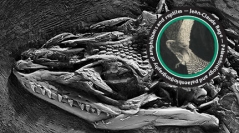

 Comptes Rendus Palevol
20 (23) - Pages 441-506
Comptes Rendus Palevol
20 (23) - Pages 441-506The evolution and interrelationships of carnivorous squamates (mosasaurs, snakes, monitor lizards, Gila Monsters) are a contentious part of reptile systematics and go to the heart of conflict between morphological and molecular data in inferring evolutionary history. One of the best-preserved fossils in this motley grouping is “Saniwa” feisti Stritzke, 1983, represented by complete skeletons from the early-middle Eocene of Messel, Germany. We re-describe it on the basis of superficial examination, stereoradiography, and high-resolution X-ray computed tomography of new and published specimens. The scalation of the lizard is unique, consisting of small, keeled scales on the head (including a row of enlarged medial supraorbitals) and large, rhomboidal, keeled scales (invested by osteoderms) that covered the rest of the body. Two paired longitudinal rows of enlarged scales ran down the neck. The head was laterally compressed and box-shaped due to the presence of a strong canthal-temporal ridge; the limbs and tail were very long. Notable osteological features include: a toothed, strap-like vomer; septomaxilla with a long posterior process; palpebral with a long posterolateral process; a lacrimal boss and a single lacrimal foramen; a well-developed cultriform process of the parabasisphenoid; two hypoglossal (XII) foramina in addition to the vagus; a lack of resorption pits for replacement teeth; and possibly the presence of more than one wave of developing replacement teeth per locus. There are no osteological modifications suggestive of an intramandibular hinge, but postmortem displacement of the angular-prearticular-surangular complex in multiple specimens suggests that there might have been some degree of mobility in the lower jaw based on soft-tissue modifications. Using phylogenetic analyses on a data-set comprising 473 morphological characters and 46 DNA loci, we infer that a monophyletic Palaeovaranidae Georgalis, 2017, including Eosaniwa Haubold, 1977, lies on the stem of Varanidae Merrem, 1820, basal to various Cretaceous Mongolian taxa. We transfer feisti to the new genus Paranecrosaurus n. gen. Analysis of gut contents reveals only the second known specimen of the cryptozoic lizard Cryptolacerta hassiaca Müller, Hipsley, Head, Kardjilov, Hilger, Wuttke & Reisz, 2011, confirming a diet that was at least partly carnivorous; the preservation of the teeth of C. hassiaca suggests that the gastric physiology of Paranecrosaurus feisti (Stritzke, 1983) n. comb. had high acidity but low enzyme activity. Based on the foregoing and linear discriminant function analysis, we reconstruct P. feisti n. comb., as a powerful, widely roaming, faunivorous-carnivorous stem monitor lizard with a sensitive snout. If the molecular phylogeny of anguimorphs is correct, then many of the features shared by Helodermatidae Gray, 1837 and Varanidae must have arisen convergently, partly associated with diet. In that case, a reconciliation of morphological and molecular data would require the discovery of equally primitive fossils on the helodermatid stem.
Palaeovaranids, Eocene, Messel, Germany, carnivorous squamates, phylogenetic relationships, new genus, new combination